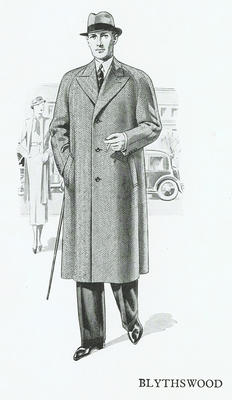
The "Blythswood" overcoat, illustrated in the Walwer styles overcoats catalogue for the winter of 1939-1940 issued by Wallace & Weir, 26 Argyle Street, manufacturers of men's and boy's clothing.
Demand for expensive clothing was adversely affected by the outbreak of the Second World War on 3 September 1939. There was a shortage of materials to make clothes, and there were strict rules stipulating how much material was to be used to make a dress, or a pair of trousers. Fashions became much simpler and people had to make their clothes last as long as possible.
In June 1941 clothes rationing was introduced, with sixty-six coupons for each adult each year. This was reduced later in the war. By the spring of 1942 each person was given only forty-eight clothing coupons a year which they could use to buy their share of new clothes. In order to be able to purchase a coat such as the one illustrated, a customer would have had to hand over sixteen of his coupons.
Reference: Mitchell Library, GC 687.1440941443 WAL
Reproduced with the permission of Glasgow City Council, Libraries Information and Archives
Keywords:
Blythswood, clothes rationing, clothing coupons, clothing manufacturers, coats, fashions, overcoats, tailors, trade catalogues, Wallace & Weir, Walwer
You have 0 images in your photo album.